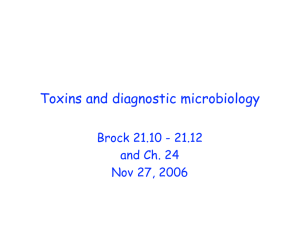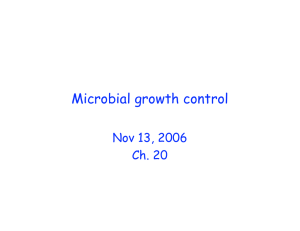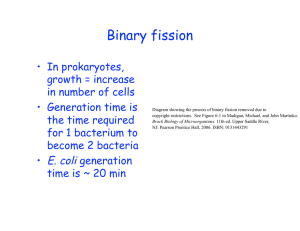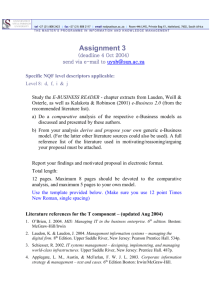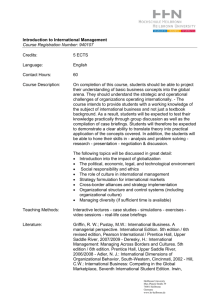Document 13539930
advertisement
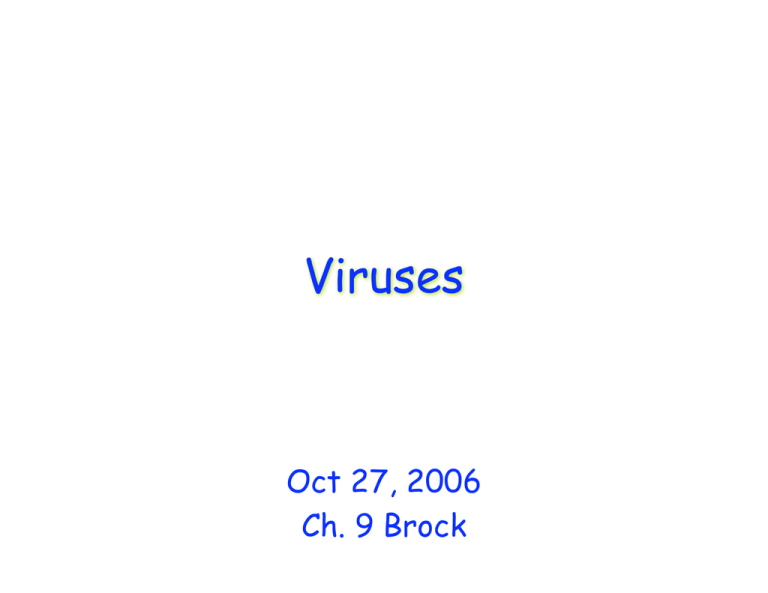
Viruses Oct 27, 2006 Ch. 9 Brock General properties of viruses • Replicate independently of the chromosome of cells, but dependent on cells • Infect animals (and people), plants, and bacteria (bacteriophage) • Extracellular forms (virions) are metabolically inert • Contain either DNA or RNA • Range in size from about 28 nm to about 200 nm in diameter • Important tools for microbial geneticists and genetic engineers Classification criteria Nucleic acid DNA RNA Symmetry of capsid Naked or enveloped ds ds (+) ss Genome architecture 10-18 seg. 2 seg. cont. (+) ss cont. Baltimore class III IV III IV Enveloped Enveloped Naked Icosahedral Helical lcosahedral (+) ss cont. IV (+) ss (+) ss (+) ss cont. 2 copies cont. IV VI IV (-) ss cont. (-) ss cont. (-) ss 3 seg. V V V Enveloped Naked (-) ss (-) ss 8 seg. cont. V V (-) ss 2 seg. V ss linear ds (+) or (-) circular II I Helical ds linear I Complex Naked/Env. Enveloped Enveloped (cytoplasmic) (cytoplasmic) ds circle gapped ds linear ds linear ds circular ds linear (x linked) I I I I I (-) (-) (-) (+) cccc ccc Properties Family name Virion polymerase Virion diameter(nm) Genome size (total in kb) Reo Birna (+) (+) Calici Picorna (-) (-) Flavi Toga Retro Corona (-) (-) (+) (-) cccc cc c Ortho- Paramyxo myxo (+) (+) (+) (+) (+) Hepadna (+) (-) (-) (-) 80 X 70790-14000 85 X 170-200 x 300-450 130-380 12 (+) 36-38 Figure by MIT OCW. Viral structure • Nucleic acid is within the protein coat (capsid) • Subunits comprising the capsid are capsomeres removed due to copyright restrictions. • Viral capsids are capable of Images See Figures 9-2b, 9-4a, and 9-4c in Madigan, Michael, and John Martinko. Brock Biology of Microorganisms. self-assembly 11th ed. Upper Saddle River, NJ: Pearson Prentice Hall, 2006. ISBN: 0131443291. • Rod-shaped viruses have helical symmetry and spherical viruses have icosahedral symmetry Additional viral structures • Some animal viruses are enveloped – Membrane is derived from host cell – Protein is viralencoded • Some bacterophage are complex – Icosahedral heads – Helical tails – Complex tail structure Images removed due to copyright restrictions. See Figures 9-3 and 9-5b in Madigan, Michael, and John Martinko. Brock Biology of Microorganisms. 11th ed. Upper Saddle River, NJ: Pearson Prentice Hall, 2006. ISBN: 0131443291. Viral growth • Number of infectious units in a viral suspension is called the titer • Can enumerate plaque-forming units (PFU) on lawns of host cells • Plating efficiency is the ratio of PFU/total virions Images of cell plating removed due to copyright restrictions. See Figure 9-6 in Madigan, Michael, and John Martinko. Brock Biology of Microorganisms. 11th ed. Upper Saddle River, NJ: Pearson Prentice Hall, 2006. ISBN: 0131443291. Animal virus methods • Animal cells can be primary or continuous culture cell lines • Plaque assays as well as cytopathic effect (CPE) can be observed Matrosovich et al. Virology Journal 3:63, 2006 Images removed due to copyright restrictions. Athmanathan et al. BMC Clinical Pathology 2:1, 2002 Viral replication • During eclipse there are no intact virions • Maturation begins with packaging of nucleic acid • Latent period begins at entry and ends with release • Lysis results in onestep growth • Burst size = yield Virion DNA (A) Attachment (adsorption) Cell (host) Protein coat remains outside (B) Penetration (injection) Viral DNA enters (C) Synthesis of nucleic acid and protein (D) Assembly and packaging (E) Release (lysis) Virions Figure by MIT OCW. Attachment and penetration • Virion binds specific receptors on the host cell surface • Penetration leads to viral uncoating • Restriction endonucleases can cleave bacterophage DNA Tail fibers Tail pins Outer membrane Peptidoglycan Cytoplasmic membrane Figure by MIT OCW. Viral replication: nucleic acids & protein Image removed due to copyright restrictions. See Figure 9-11 in Madigan, Michael, and John Martinko. Brock Biology of Microorganisms. 11th ed. Upper Saddle River, NJ: Pearson Prentice Hall, 2006. ISBN: 0131443291 Classification criteria Nucleic acid DNA RNA Symmetry of capsid Naked or enveloped ds ds (+) ss Genome architecture 10-18 seg. 2 seg. cont. (+) ss cont. Baltimore class III IV III IV Enveloped Enveloped Naked Icosahedral Helical lcosahedral (+) ss cont. IV (+) ss (+) ss (+) ss cont. 2 copies cont. IV VI IV (-) ss cont. (-) ss cont. (-) ss 3 seg. V V V Enveloped Naked (-) ss (-) ss 8 seg. cont. V V (-) ss 2 seg. V ss linear ds (+) or (-) circular II I Helical ds linear I Complex Naked/Env. Enveloped Enveloped (cytoplasmic) (cytoplasmic) ds circle gapped ds linear ds linear ds circular ds linear (x linked) I I I I I (-) (-) (-) (+) cccc ccc Properties Family name Virion polymerase Virion diameter(nm) Genome size (total in kb) Reo Birna (+) (+) Calici Picorna (-) (-) Flavi Toga Retro Corona (-) (-) (+) (-) cccc cc c Ortho- Paramyxo myxo (+) (+) (+) (+) (+) Hepadna (+) (-) (-) (-) 80 X 70790-14000 85 X 170-200 x 300-450 130-380 12 (+) 36-38 Figure by MIT OCW. Virulent bacteriophage • T-even phage are closely related – T4 is best studied • ds linear DNA – 169 kb (> 250 proteins) – Circularly permutated • 5-hydroxy methylcytosine – Glucosylated base is resistant to restriction enzymes Image removed due to copyright restrictions. See Figure 9-12 in Madigan, Michael, and John Martinko. Brock Biology of Microorganisms. 11th ed. Upper Saddle River, NJ: Pearson Prentice Hall, 2006. ISBN: 0131443291. T4 infection Nucleases DNA polymerase New sigma factors Infection Phage DNA replication Middle mRNA Early mRNA Early proteins 0 Phage head proteins Phage DNA 5 Minutes Late proteins 15 Mature phage particle T4 lysozyme production Self assembly Late mRNA Middle proteins 10 Tail, collar, base plate, and tail fiber proteins Lysis 20 25 Figure by MIT OCW. Temperate bacteriophage • Can complete lytic cycle or become a prophage (lysogeny) – Most viral genes not expressed – Genome replicated synchronously with host genome • Lysogens can become activated and undergo lytic replication Image removed due to copyright restrictions. See Figure 9-16 in Madigan, Michael, and John Martinko. Brock Biology of Microorganisms. 11th ed. Upper Saddle River, NJ: Pearson Prentice Hall, 2006. ISBN: 0131443291. Phage lambda 1. DNA circularlizes 2. Expression of N and Cro 3. Antitermination L1 and L2 (some Q) 4. Q antitermination R2 5. Cro acts as a repressor on OL and OR 6. Blocks expression of cI and cII (lysis) 7. Rolling circle replication Image removed due to copyright restrictions. See Figure 9-18b in Madigan, Michael, and John Martinko. Brock Biology of Microorganisms. 11th ed. Upper Saddle River, NJ: Pearson Prentice Hall, 2006. ISBN: 0131443291. Lysogeny • To prevent late gene expression, cI (lambda repressor) must be Image removed due to copyright restrictions. expressed See Figure 9-19 in Madigan, Michael, and John Martinko. Brock Biology of • PE is activated by cII Microorganisms. 11th ed. Upper Saddle River, NJ: Pearson Prentice Hall, 2006. ISBN: 0131443291. • Stabilized by cIII • cI also represses at OL and OR, but in opposite order of Cro (lysogeny) • PM is activated once OR is fully bound by cI Animal viruses • Can result in lytic infection, persistent infection, or latent infection • Some viruses can transform the host cell Image removed due to copyright restrictions. See Figure 9-24 in Madigan, Michael, and John Martinko. Brock Biology of Microorganisms. 11th ed. Upper Saddle River, NJ: Pearson Prentice Hall, 2006. ISBN: 0131443291. Virus-like agents • Viroids are small, circular ss RNA molecules • Encode no proteins • Prions are infectious proteins • Contains no nucleic acid • Cause transmissible spongiform encephalopathies (TSEs) Image removed due to copyright restrictions. See Figure 9-29 in Madigan, Michael, and John Martinko. Brock Biology of Microorganisms. 11th ed. Upper Saddle River, NJ: Pearson Prentice Hall, 2006. ISBN: 0131443291.
